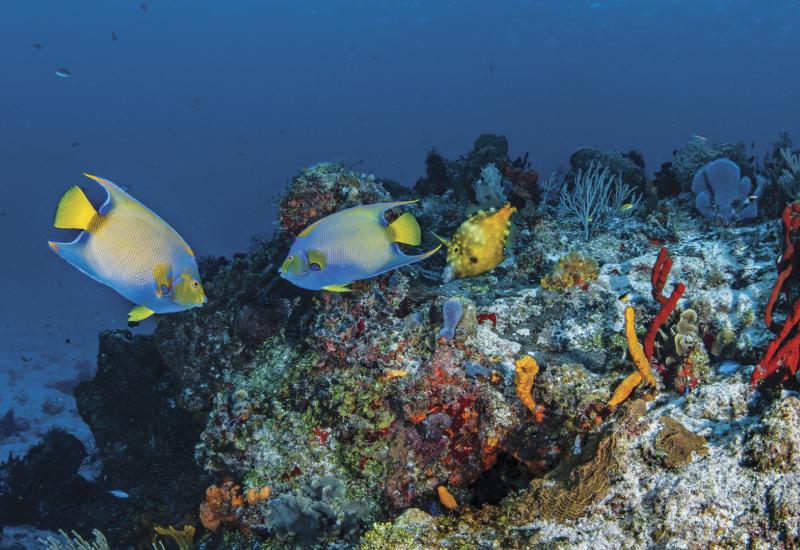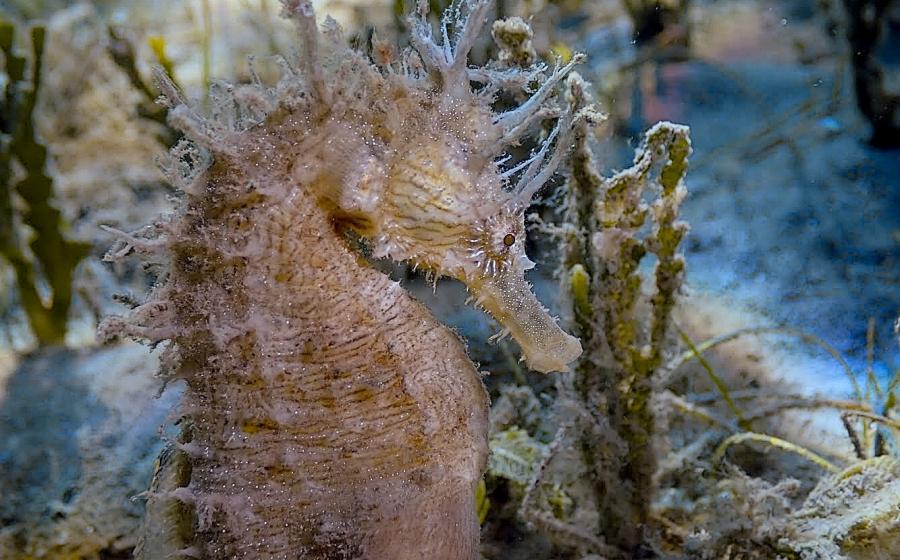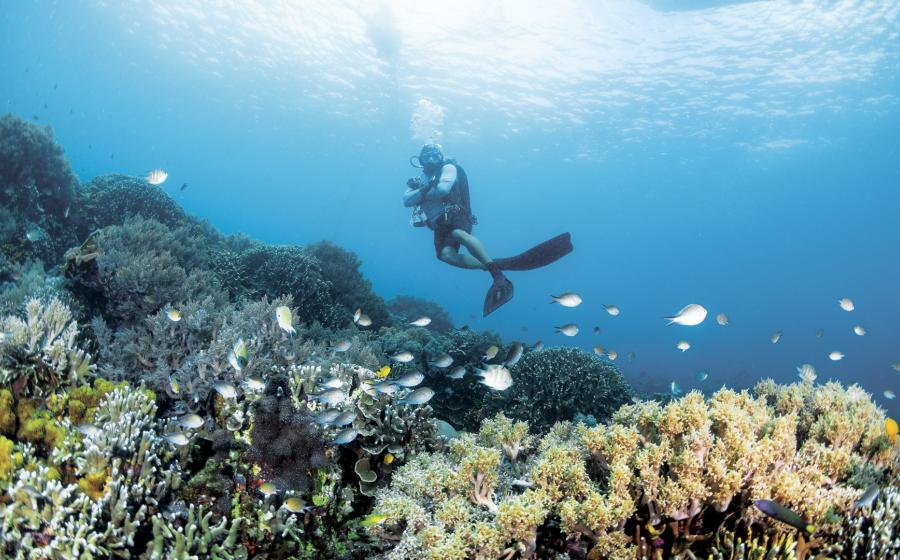Scuba Diving in Cozumel!

Hard-core divers with time and money to burn will charter planes, boats, camels — whatever — in their pursuit of awesome reefs, abundant marine life and adrenaline-fueled drifts along coral-laced underwater walls. And for many divers, the perceived level of adventure at any given dive destination exists in direct relation to the distance traveled off the beaten track to dive there. Cozumel is the exception to this way of thinking. With direct flights from many major U.S. hubs, this current-swept island off Mexico's Yucatan peninsula is arguably one of the most accessible and affordable dive destinations in North America, but this backyard beauty boasts an unprecedented variety of top-notch dive sites.
Enjoy looking for macro life in the cracks and crevices of a shallow reef? You could burn a year's worth of tanks searching for seahorses, pipefish and fingernail-sized nudibranchs in Cozumel's coral gardens. Prefer twisting and turning through a maze of underwater canyons, pinnacles and swim-throughs? Cozumel's mid-reef formations put the minotaur's labyrinth to shame. And what about walls? In Cozumel, they're deep, vertical and bathed by stiff currents, schooling fish and the occasional pelagic. And like any destination that truly understands the draw of its underwater treasures, Cozumel's impressive dive infrastructure makes your time here as easy and relaxing as you'll find anywhere in the world.
Step off the plane and there's no rush of aggressive taxi men to haggle with for a ride. A taxi counter sells fares at a fixed rate, which makes getting to your hotel or guesthouse in and around nearby San Miguel a breeze. Plus, most locals speak English in addition to Spanish, the dollar is the de facto form of currency and because diving is the name of the game, any place you stay will have a system for getting you and your gear to the boat with no stress included. Underwater, the game stays the same. As the unofficial drift diving capital of the Caribbean, Cozumel's diving is about as easy as it gets. The sites don't have moorings because live-boat drifts come standard. Just back roll or giant stride over one of the sprawling reefs or plunging walls, make a quick descent with your group and effortlessly ride the flow behind your dive guide until you're out of time or air--then make your ascent and let the boat come to you, rather than the other way around. And with a great collection of capable dive operators catering to everyone from noobs to techies, you're certain to find one that fits your specific needs, location and experience level.
Along the southwest side of the island--which faces the mainland across the current-swept channel--you'll find the bulk of Cozumel's dive sites. The island itself is basically a limestone coral cap sitting atop an underwater plateau, the edges of which slope down gently from the shore until they meet the steeply angled edge that transitions into a vertical wall. Because Cozumel's dive sites generally fall into one of three categories, we've divided them based on their location along the island's underwater terrain:

Shallow Coral Gardens
These near-shore sites are personified by long, shallow — usually 25 to 60 feet — strips of reef interspersed with sandy channels and flats areas. These are great second and third dives because the shallow depths provide ample bottom time to bathe among the sun-drenched, fish-filled corals or cruise nonchalantly with the current over rolling hills and valleys.
Colombia Shallow
A long backbone of reef between 10 and 30 feet deep crisscrossed by sand channels, overhanging ledges and short swim-throughs. This makes a great second dive when your first is on one of the outer walls, where you'll likely redline your nitrogen levels. Unless there's a southern wind, this site is well protected, with calm surface conditions and little current. But don't let the ease of this dive fool you. Elkhorn corals, turtles and an impressive collection of reef fish litter the landscape, and the shallow depths give you tons of bottom time for scouring the pockmarked reef for small stuff like pipefish and splendid toadfish.
Tormentos Reef
True to its name, this site can have hair-whipping currents that sweep you like pelagic plankton over the crests and valleys of rolling hills and reefs. Recent hurricanes did knock down some of this site's once famous stands of large brain corals and barrel sponges, but fresh growth is abundant, and the marine life is here in force. Loads of oceanic triggerfish and angelfish graze along the hillsides, and a good divemaster can spot seahorses and other cool macro life.
Cardona Reef
This low-profile reef has a maximum depth of about 45 feet. The highlight here is a long series of overhanging ledges that harbor loads of squirrelfish, glassy sweepers, cardinalfish and spotted drums.
Paradise Reef
Because this garden of shallow patch reefs is less than a 10-minute boat ride from the docks of San Miguel, it's a popular night dive. The reef sprawls across a flat sandy area that ranges from about 20 to 50 feet deep. You can zigzag back and forth across the scattered gorgonian-fringed coral stands looking for the little stuff, and at night this area pops with color and nocturnal life: Octopus roam the reef looking for midnight snacks, spiny and slipper lobsters scuttle around on the bottom and Caribbean reef squid shimmer in the water column.

Mid-Water Reefs and Pinnacles
Truly a diver's playground, this category comprises Cozumel's sites with the most dramatic underwater topography. Along the transitional part of the slope, dramatic limestone pinnacles, canyons, swim-throughs and rounded coral mounds, carved out by the area's steady current, make up the top part of the wall. A good dive guide will lead you on incredible winding paths, showing you killer passageways cut in the rock and letting you dive not just on the reef but inside it as well.
Palancar Caves
This is just one of a handful of sites along the 3-mile-long Palancar reef, the area's biggest. The top starts in the shallows and slopes to the edge of the wall at about 100 feet. In between, the reef is punctuated with an endless maze of swim-throughs and cathedral-like rooms with multiple entries and exits through which shafts of light illuminate the darkness. This is a wonderland for divers who love dramatic terrain, and the abundant marine life includes larger oceangoing critters like spotted eagle rays and black-tip reef sharks.
Paso De Cedral
A relatively flat reef with hills that roll to the edge of the drop, Cedral Pass ranges from about 40 feet to more than 100. This is another place where the current gets cooking. Leave the camera on the boat when there's a good flow, and just enjoy the rippin' ride. There are plenty of ledges and hills along the reef to duck out of the current, and when you do, look for eels and nurse sharks taking refuge along with you.
Palancar Horseshoe
Named for the horseshoe-shaped rock amphitheater carved into the reef, this site ranges from about 30 feet out to the wall. The maze of caves and coral-covered rock formations makes for a lovely meandering dive along the deeper section. Turtles, black-tips and grouper are all likely sightings.
Vertical Walls

This is where the reef meets the blue water. Deep-water corals and rock formations jutting out perpendicular to the wall into the abyss exemplify this category.
Santa Rosa Wall
Winding tunnels start at the top of the wall and run to the steep edge of the sponge- and coral-encrusted wall. Boulders and formations fringe this wonderfully colorful site, and the wall is long so you can easily do multiple dives without covering the same areas. Currents can be strong here on the less protected southern reefs, but Santa Rosa's large formations offer ample opportunities to duck in and out of the flow. Look under the rock lips that jut off the wall to see huge black grouper and the occasional barracuda.
Palancar Deep
Just south of Palancar Caves. This deepest manifestation of Cozumel's largest reef starts at about 40 feet and drops well into the channel. Cracks and chasms slash the reef wall, and the spaces in between overflow with soft corals, anemones, and as small fish dart in and out of the reefscape, larger groupers hang out under ledges and jacks cruise the edge.
Colombia Deep
This exposed reef lies just south of the island, and it's subject to strong currents and surface conditions. But the often stellar visibility paired with terrain comprising forests of steep coral and rock pinnacles shaped by the strong currents make this a can't-miss dive. Giant grouper and lazy sea turtles tuck into the ledges, and the site's proximity to the drop-off makes encounters with sharks and rays a distinct possibility.
Punta Sur
Starting at 100 feet and plunging into the depths, this site is for experienced divers only. Devil's Throat--a long vertical cave that pops out of the wall at about 130 feet--is the most famous section of this reef. Dodgy conditions can make this spot hit-or-miss, and the whole boat needs to be experienced and comfortable to dive here.
On the Fringe

The northern stretch of the west-side wall, the far south and choice spots on the east side of the island are where you'll find the hard-to-get-to dive sites, and diving on the fringe in Cozumel often requires experience, patience and a little luck. We talked to Memo Mendoza of Aldora Divers and Christi Courtney of Blue XT Sea Diving about what you need to know to get there. Most important, you need to be honest about your experience level, plan ahead and dive with the same group for your whole trip. "If you're only diving a day or two with us, your chances are very slim," Courtney says. "Regardless of what level C-card you hold, until we know you as a diver we can't take you to these sites. I often say 'don't tell me--show me.'"
Goin' North
Barracuda and San Juan Reefs
Screaming currents, untouched reefs, looming rock ledges and an above average shot at big pelagics are the highlights of this rarely visited site.
Conditions Downcurrents or currents pulling away from the wall make it easy for divers to get separated, and rough surface conditions can make it hard for the captain to follow the divers or see them on the surface. Boats can't take divers here without prior permission from the harbormaster.
Experience--Expert "Barracuda requires a tremendous sense of team," Mendoza says. "With currents that strong, everything gets magnified. It's not like diving Palancar where, if you get separated from the group, you can just come up on your own and the boat can pick you up."
The Far South
Chun Chacab and Maracaibo Reefs
Maracaibo Wall is a deep dive, often around 130 feet, where amazing rock formations include a massive archway. Maracaibo Shallows and rarely dived Chun Chacab offer pristine corals unlike anything on the island. "The reefs don't get the same stress that the closer ones get. It's never crowded," Courtney says. "And most of the big pelagic life I've seen in Cozumel, I've seen at Maracaibo."
Conditions Rough surface conditions, fast currents and deep dives--need we say more?
Experience — Expert "Divers need excellent buoyancy skills and kicking techniques," Mendoza says. "They also need to know how to use their computers, how to follow a contingency plan and have good air consumption."
Braving the Windward Side
Los Atolones and the Galleon
The draw of the east side is the draw of virgin territory, sites unseen by other divers. There are unique formations called Los Atolones--mini atolls formed by freshwater bubbling through the limestone substrate--vast elkhorn forests unlike anywhere in the Caribbean and the wreck of a Spanish galleon, with 17 canons and two giant anchors. "We explore in areas without cars, developments or human establishments," Mendoza says. "It awakens the conquistador spirit."
Conditions The east side is pounded by wind and waves about half the days out of the year, so you need to have a light wind, or wind coming from the north or southwest, to dive there. Tell Mendoza on your first day if want to dive the east side. He'll watch the wind, and if a day looks good, he'll drive over and double check the conditions early so you can still make it on the regular boats if it doesn't work out.
Experience — Intermediate "You have to be a self-dependent diver," Mendoza says. "Comfortable in a small boat on choppy water, able to set up your own gear and able to care for yourself within the group."

Dive In
Water Conditions: Water temperatures vary from 75 degrees in winter to 85 degrees in summer, but you can count on 100 feet of visibility just about year-round.
Weather: Cozumel averages a balmy year-round temperature of about 80 degrees. During the May-to-October rainy season, expect afternoon thundershowers that quickly drench the island.
Documents: A passport is required.
Getting There & Around: Most major domestic air carriers offer service to Cozumel (CZM) either by themselves or via a codeshare partner. Many folks fly into Cancun (CUN) — which can be cheaper to fly into — then catch a "colectivo," or shared van, to Playa del Carmen, and hop on a ferry to Cozumel.
Money Matters: The Mexican peso; dollars are widely accepted by most businesses, as are traveler's checks and credit cards. Exchange rate is approximately 10 pesos to US$1, though it fluctuates. Departure tax is usually included in the price of your airline ticket.










